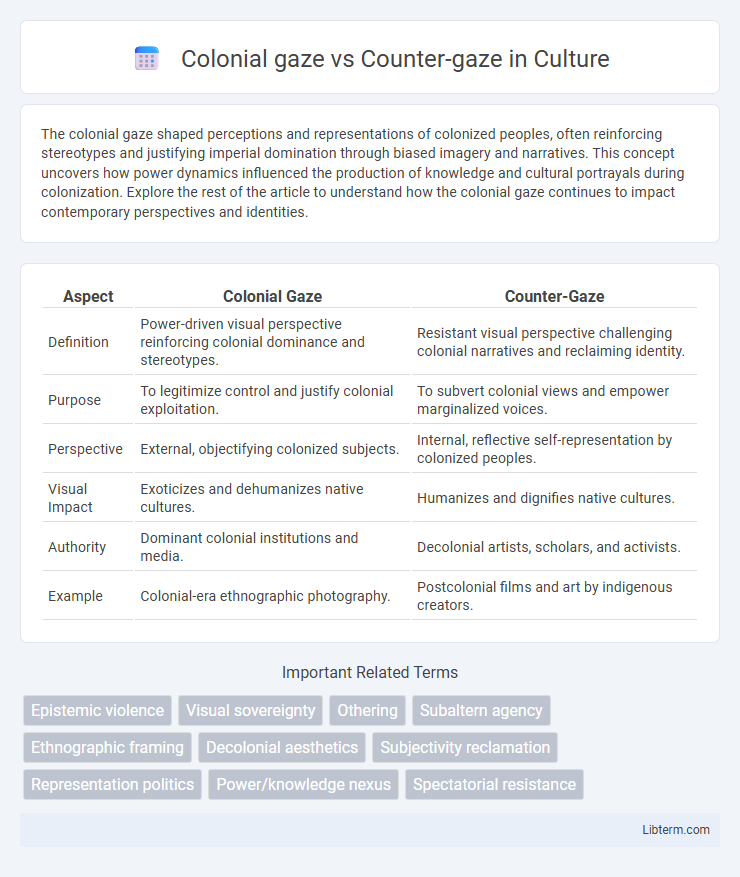The colonial gaze shaped perceptions and representations of colonized peoples, often reinforcing stereotypes and justifying imperial domination through biased imagery and narratives. This concept uncovers how power dynamics influenced the production of knowledge and cultural portrayals during colonization. Explore the rest of the article to understand how the colonial gaze continues to impact contemporary perspectives and identities.
Table of Comparison
| Aspect | Colonial Gaze | Counter-Gaze |
|---|---|---|
| Definition | Power-driven visual perspective reinforcing colonial dominance and stereotypes. | Resistant visual perspective challenging colonial narratives and reclaiming identity. |
| Purpose | To legitimize control and justify colonial exploitation. | To subvert colonial views and empower marginalized voices. |
| Perspective | External, objectifying colonized subjects. | Internal, reflective self-representation by colonized peoples. |
| Visual Impact | Exoticizes and dehumanizes native cultures. | Humanizes and dignifies native cultures. |
| Authority | Dominant colonial institutions and media. | Decolonial artists, scholars, and activists. |
| Example | Colonial-era ethnographic photography. | Postcolonial films and art by indigenous creators. |
Understanding the Colonial Gaze: Origins and Implications
The colonial gaze originated during European imperialism, shaping perceptions by framing colonized peoples as exotic, inferior, and subjugated objects of study and control. This gaze imposed power dynamics that reinforced racial hierarchies and justified colonial domination through visual and cultural representation. Understanding the colonial gaze reveals how these entrenched ideologies continue to influence postcolonial identities and contribute to ongoing systemic inequalities.
The Impact of the Colonial Gaze on Representation
The colonial gaze imposed distorted representations by framing colonized subjects as exotic, inferior, or subhuman, reinforcing power hierarchies and justifying domination. This perspective marginalized indigenous voices and suppressed authentic cultural identities, shaping historical narratives through the colonizer's viewpoint. The counter-gaze challenges these distortions by reclaiming agency, promoting self-representation, and offering alternative narratives that resist colonial stereotypes and assert postcolonial identity.
Mechanisms of Power in Colonial Visuality
Colonial gaze operates through mechanisms of power that objectify and control colonized subjects by imposing visual frameworks reinforcing dominance and exoticism. Counter-gaze subverts this dynamic by reclaiming visual agency, enabling colonized peoples to resist and reinterpret imposed representations. These mechanisms reveal how visuality functions as a tool of colonial power and resistance within the broader context of imperialism.
Counter-Gaze Defined: Resisting Colonial Perspectives
The counter-gaze is a powerful act of resistance that challenges colonial perspectives by reclaiming the narrative and disrupting imposed stereotypes. It empowers marginalized communities to assert their own identities and histories, rejecting objectification and dominant colonial interpretations. By turning the gaze back on colonial structures, the counter-gaze subverts power dynamics and promotes decolonial visual sovereignty.
Case Studies: Counter-Gaze in Art and Literature
The counter-gaze in art and literature subverts colonialist perspectives by reclaiming narrative authority through indigenous and marginalized voices, as seen in Frantz Fanon's critique of colonial representation and in the works of writers like Chinua Achebe and artists such as Kara Walker. These case studies highlight how counter-gaze strategies expose colonial power dynamics and create spaces for postcolonial identity formation. By challenging the colonial gaze, counter-gaze practices emphasize agency, resistance, and the rearticulation of history from the standpoint of the oppressed.
Media and the Evolution of Counter-Gaze
The colonial gaze in media imposed stereotypical representations that reinforced power imbalances and cultural subjugation, depicting colonized peoples through a lens of exoticism and inferiority. The evolution of the counter-gaze emerged as a critical response, enabling marginalized communities to reclaim their narratives and challenge dominant portrayals by producing authentic and self-representative content. This shift in media highlights the importance of visual sovereignty and the ongoing struggle for decolonizing storytelling frameworks.
Indigenous Self-Representation as Counter-Gaze
Colonial gaze imposes external interpretations and stereotypes on Indigenous peoples, often marginalizing their voices and identities. Indigenous self-representation as counter-gaze actively challenges these imposed narratives by reclaiming agency and expressing authentic cultural experiences. This act of resistance through art, media, and storytelling redefines Indigenous identity on their own terms and disrupts colonial power structures.
Decolonizing Narratives Through Counter-Gaze
The colonial gaze constructs narratives that exoticize and subjugate colonized subjects, reinforcing power imbalances and cultural stereotypes. Counter-gaze challenges these imposed representations by reclaiming agency and self-definition, enabling marginalized voices to disrupt colonial discourses. Decolonizing narratives through counter-gaze foster authentic storytelling that centers indigenous perspectives, reshapes historical memory, and promotes epistemic justice.
Contemporary Relevance of Colonial Gaze and Counter-Gaze
The colonial gaze persists in contemporary media and cultural representations, reinforcing power dynamics and stereotypes rooted in historical imperialism. Counter-gaze emerges as a critical tool that challenges and subverts these dominant narratives by reclaiming agency and authentic identity expression. This dialectic shapes ongoing conversations in postcolonial studies, visual culture, and social justice movements, highlighting the enduring impact of colonial legacies on perception and representation.
Toward a Plurality of Perspectives: Beyond the Colonial Binary
The colonial gaze constructs identity and power through Eurocentric frameworks, imposing a singular narrative that marginalizes indigenous voices and knowledge systems. Counter-gaze challenges this dominance by reclaiming agency, enabling subaltern perspectives to decolonize representation and assert multiplicity in experience and meaning. Toward a plurality of perspectives involves decentering colonial binaries, fostering dialogues that embrace cultural diversity and epistemic justice in postcolonial discourse.
Colonial gaze Infographic

 libterm.com
libterm.com